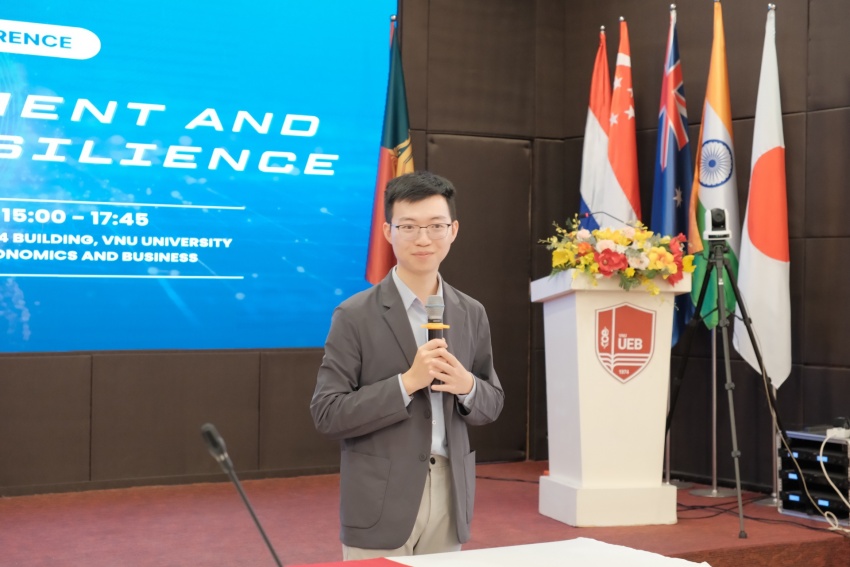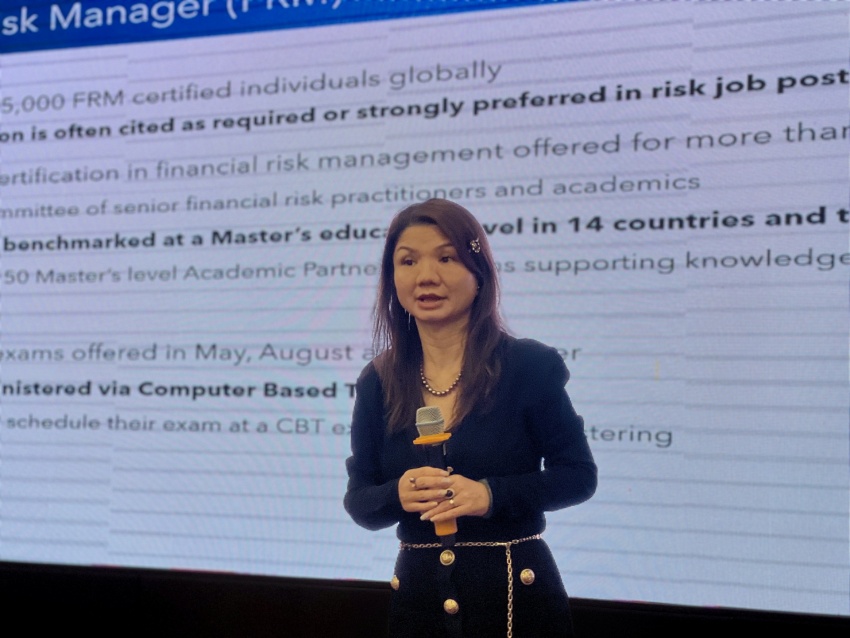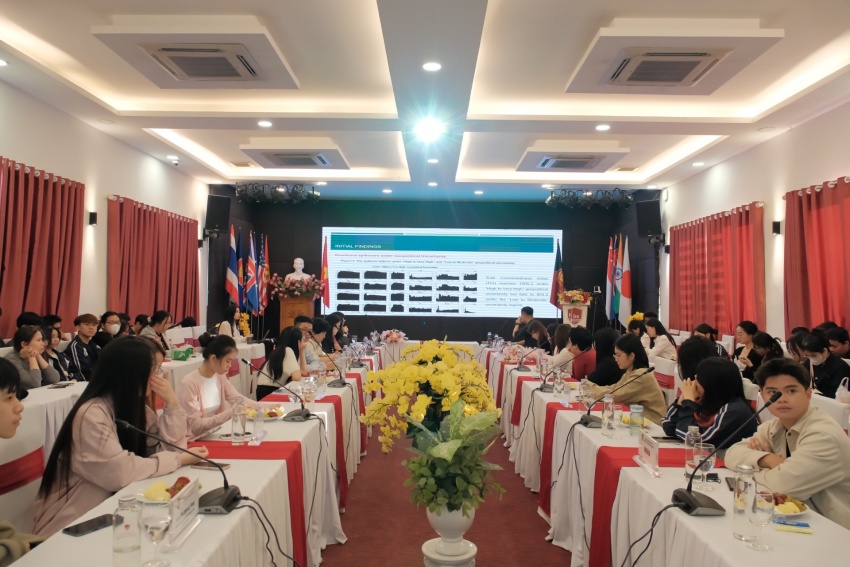On November 14, VNU-UEB hosted an international conference on 'Risk Management and Financial Resilience', convening scholars, policymakers, and industry specialists to discuss emerging trends in risk management, financial innovation, and fintech, with particular emphasis on green growth and sustainable development.
 |
| Le Hong Thai, deputy dean of the Faculty of Finance and Banking at VNU-UEB |
Le Hong Thai, deputy dean of the Faculty of Finance and Banking at VNU-UEB, believes that the world is entering a period of unprecedented uncertainty marked by financial instability, geopolitical conflicts, climate change, and technological disruptions. These challenges require financial systems not only to withstand shocks but also to demonstrate strong capacity for recovery and adaptation.
“Financial risk management is no longer just a technical function, it has become a strategic instrument to build resilience for the entire economy,” he said.
Global studies by international organisations indicate that financial resilience is defined by the ability to remain stable during crises while also having the capacity to transform risks into opportunities. According to Thai, three core pillars underpin financial resilience: modern risk-management systems, technological and data-driven innovation, and flexible regulatory frameworks.
The first pillar is an effective risk-management system that enables early detection and proactive responses. Thai noted that modern frameworks must integrate both financial and non-financial risks, including climate, geopolitical, cyber, and behavioural risks. Tools such as stress testing, early-warning systems, and scenario-based modelling are becoming global standards, helping institutions transition from reactive to predictive risk management.
The second pillar is technological innovation. The convergence of AI, machine learning, big data, and cloud computing is revolutionising forecasting capabilities and risk-control mechanisms. “Real-time analytics improve fraud detection and optimise capital allocation. Meanwhile, the rise of RegTech and SupTech allows regulators to supervise the financial system with greater agility and precision,” Thai explained.
The third pillar is a forward-looking institutional and policy framework. Strong institutions don't just mitigate risks, they also encourage responsible innovation, supporting safe experimental environments for fintech models. Countries such as Singapore, South Korea, and those in the EU exemplify how macroeconomic stability and rapid digital-finance growth can coexist under robust governance.
Linked to all three pillars is the central role of digital transformation. Thai stressed that digitalisation is not merely about automating processes but restructuring the entire financial ecosystem, from data, digital infrastructure, and decision-making models to oversight mechanisms.
“A resilient financial system in the twenty-first century must be digital, intelligent, and inclusive,” he concluded.
 |
| Shania Fang-I Chien, vice president of Business Development Asia at Global Association of Risk Professionals |
From an international perspective, Shania Fang-I Chien, vice president of Business Development Asia at Global Association of Risk Professionals (Hong Kong SAR), noted that digital transformation has reshaped financial intermediation by making services faster, cheaper, and more accessible. However, it has also amplified cyber-security risks and operational vulnerabilities. The World Economic Forum’s 2025 Global Risks Report ranks cyberattacks and digital-infrastructure failures among the most severe threats to global financial stability.
“Cyber-security risk management is becoming a core component of financial governance,” she said. Regulatory authorities such as Monetary Authority of Singapore and European Banking Authority have issued comprehensive guidelines on technology-risk management and operational resilience. These frameworks emphasise preparedness, incident reporting, and cyber-attack simulations to ensure uninterrupted financial-system operations.
Bui Thanh Hang from the National Agency for Technology Entrepreneurship and Commercialisation Development noted that the global financial environment is increasingly interconnected and complex, requiring risk management to be data-driven, adaptive, and cross-sectoral.
“Building financial resilience is a long-term process that depends heavily on institutional learning, data sharing, and policy innovation. The intersection of digital transformation, climate finance, and global regulatory reform presents both major opportunities and significant challenges for developing economies,” she said.
Hang acknowledged that Vietnam has made strong progress in digitalisation, financial inclusion, and macroeconomic stability but continues to face gaps in risk-management capabilities and alignment with international standards.
According to Hang, strengthening financial resilience requires four priority measures: developing a comprehensive macroprudential framework that integrates banking, insurance, and capital markets; upgrading risk-data infrastructure to enable predictive analytics and early-warning systems; investing in cybersecurity and digital-risk governance to safeguard the rapidly expanding digital finance sector; and enhancing collaboration among regulators, financial institutions, and academia to support evidence-based policymaking.
“By advancing these initiatives, Vietnam can not only address its existing vulnerabilities but also position itself as a regional leader in sustainable finance,” she said.
 |
Concluding the conference, the leadership of the Faculty of Finance and Banking at VNU-UEB delivered three groups of policy recommendations for Vietnam.
In the short term, Vietnam should strengthen the monitoring of systemic risks, especially risks emerging from digital technology, digital assets, and cyber-security. Improving the legal framework and adopting smart-supervision technologies such as RegTech and SupTech will help authorities detect early warning signs and prevent contagion.
In the medium term, the country must develop a high-quality workforce at the intersection of finance and technology, equipped with skills in AI, big data, and machine learning for risk-management applications. Partnerships between universities, research institutes, regulators, and the private sector will be essential to foster innovation and knowledge transfer.
In the long term, the conference recommended that Vietnam establish an integrated strategy linking digital transformation with green growth. Digital technologies should support emission reduction, green finance, and climate-finance initiatives, helping build a transparent, adaptive, and climate-resilient financial ecosystem.

















































